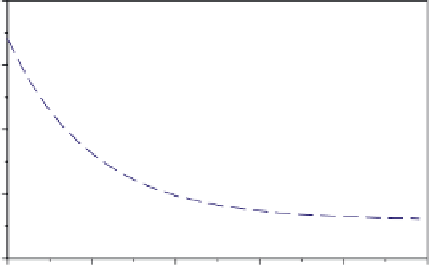Biomedical Engineering Reference
In-Depth Information
140
E
(GPa)
120
E
app
(a/t)
100
80
E
s
60
0
1
2
3
4
5
a/t
FIGURE 17.5
Apparent elastic modulus
E
app
as a function of relative
depth of indenter penetration into a coating (a schematic).
E
s
—substrate modulus,
a
—contact radius,
t
—coating
thickness. The coating modulus
E
c
is obtained by
extrapolation of
E
app
(
a/t
) for
a/t
→
0.
The series of
X
(
h
) values is then fitted by a smooth curve, and the surface value is obtained by its
extrapolation to
h
0,
Figure 17.5
. Pointed indenters are better, as the impression shape does not
depend on the depth of penetration. At least 4-5 values are necessary in order to reveal trends in the
property distribution. The devices working with small harmonic oscillations (CSM or DMA mode) are
better, as they can yield the necessary series of
X
(
h
) data in one test.
More complex is the situation with coatings, where the change of properties at the interface is
sudden. A rule of thumb says that if the indentation depth is less then 1/10 of the coating thickness,
only its property is measured. However, this holds only for hardness, especially if the layer is softer
than the substrate. The apparent (as measured) elastic modulus is influenced by the substrate prop-
erties beginning from the minimum loads. Again it is necessary to make a series of tests for vari-
ous depths and extrapolate the
X
(
h
) values to
h
0. It is reasonable to work with nondimensional
penetration
ξ
, defined as
h
/
t
or
a
/
t
, where
h
,
a
, and
t
are depth, contact radius, and coating thickness,
respectively. The fitting function has general form
[21,22]
:
X
( )
ξ
X
Φ
( )
ξ
X
[
1
Φ
( )]
ξ
(17.14)
c
s
where
X
c
and
X
s
is the property of the coating and the substrate, Φ(
ξ
) is a nondimensional weight
function, which decreases from 1 for
ξ
0 (or
h
0) to zero for
h
»
t
. Knowing the substrate prop-
erty
X
s
from independent measurements, one can obtain the coating property
X
c
as a regression con-
stant by fitting the
X
(
ξ
) values by Eq. (17.9) with a suitable function Φ.
Several weight functions have been proposed. For elastic modulus, Doerner and Nix
[23]
used a
simple exponential function
Φ( )
ξ
exp
[
(
c
ξ
)]
(17.15)




















